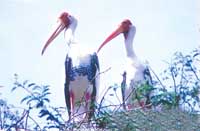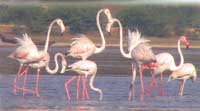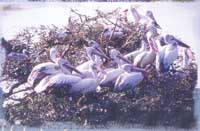|
• During the last few decades, an increase in destruction and degradation of several estuaries and wetlands has been taking place all over the world, almost to the point of their total disappearance.
Traditional management practised by some people in India has been instrumental in protecting local ecosystems, their natural resources, biodiversity and in ensuring the livelihood security for the local poor who are dependent on such ecosystems for their survival. One of the areas where this was practised near Madras was in the Pulicat Lake area and its hinterland.

Nesting Painted Storks |
Increasing human population and industrialisation during the last few decades have, however, led to an increasing pressure on this ecosystem. In order to work out a programme for sustainable development in this area where the diversity has been seriously affected, a study was undertaken between 1999 and 2004 by Dr. P.J. Sanjeeva Raj and Odd W. Jacobsen of Bergen University College, Norway, to obtain some of the information necessary on the distribution and abundance of both plants and animals and their ecological relationships. They focussed their study on the wintering wetland birds and their numbers in the northern parts of the Pulicat Bird Sanctuary and prepared a checklist. Based on this information they discuss management implications to preserve the avian biodiversity in this wetland ecosystem. When Pulicat Lake is, as it should be, declared a Ramsar Site for international protection, this checklist will be useful for the management of this wetland.
Pulicat Lake on the border of the States of Andhra Pradesh and Tamil Nadu is the second largest coastal lagoon in India, having an area of about 300 square km. The Lake, a vast wetland for waterfowl, is protected by the Forest Department of Andhra Pradesh Government.
Since it is a shallow lagoon with rich and diverse food resources, about 80 species of waterfowls, especially ducks and waders, visit this lagoon from October to March. Some species, like the flamingo (Phoenicopterus roseus), occur in great numbers throughout the winter. About 15 different species nest in the nearby sanctuaries of Nelapattu, Bodilingalapaadu and Vedurupattu Bird Sanctuaries. For all these breeders and for their nestlings, Pulicat Lake is the only major feeding ground.
The northern region of Pulicat Lake is particularly attractive to wading birds, because of its shallow waters and loose silt that support rich benthic and buried fauna.
Until recent times, Pulicat Lake has been supporting rich and diverse fisheries from which a large population of the rural poor eked a living. Unfortunately, during the last 30 years, the Lake has increasingly become a victim of diverse environmental tragedies, including over-fishing, habitat fragmentation, and pollution, from chemical fertilisers, pesticides and thermal power. Prawn farms not only drain the little water left over during the summer, but also discharge untreated effluents from the farms into the lake. Consequently, the benthic habitats as well as their benthic communities of organisms get degraded and depleted, as a result of which the natural food-chains and food-webs of wetland birds have been seriously affected. Siltation of the Lake is another factor, reducing the water-holding capacity so that the water in the Lake does not last long enough for continued feeding and breeding of birds. Unless a crash programme for the sustainable development of Pulicat Lake is evolved and implemented immediately, this lagoon will face imminent danger of sequential degradation into small pools, salt marshes, mudflats and, ultimately, a sure “ecological death”.
The data of the Sanjeeva Raj- Jacobsen study is partially presented here. It was collected during the winter months of December to February 1999 to 2004, for the most part in the mornings between 6 and 10, and in the afternoons between 3 and 6.30. The birds were observed from selected vantage points, mainly on the road from Sullurpet town to Sriharikota.
During the study, 74 species were observed. For the purposes of this article* we include notes on the migrants seen in the largest numbers and the unique species.

The flamingos of Pulicat.
(All pictures used in the article are by ODD W. JACOBSEN.)
|
Spotted-billed Pelicans were observed in numbers varying from 120 to 250. Their method of fishing is by a cooperative effort, a flotilla of birds swimming in a semicircle or from bank to bank, across an arm of the lake. At the same time, they vigorously splash on the water with their large wings to drive the school of fish into the shallow waters. Frequently, Spotted-billed Pelicans feed close to local fishermen, and some kind of symbiotic behaviour has developed between fishermen and pelicans.
Little Cormorants, the most common cormorants in India, have been recorded in the range of 50-350 individuals.
Little Egrets are the most common egrets on the Lake which congregate in flocks in shallow water along the bridges on the road from Sullurpet town to Sriharikota. The numbers spotted vary from 100 to 250. The Lake is an important feeding and roosting ground for the Little Egrets, which nest in nearby villages or in sanctuaries.
Large Egrets, a common species on Pulicat Lake, occur in counts varying between 50 and 200 individuals. The Large Egret is frequently seen together with the Little Egret.
Cattle Egrets are the most characteristic resident egret in paddy fields around Pulicat Lake, where the birds sometimes congregate in large flocks. Upto 120 a day have been spotted.
Pond Herons were mostly observed in nearby paddy fields. The Pond Heron relies on its camouflaging plumage. Spottings are around 60 a day.
Grey Herons found in shallow waters, normally solitarily or in groups of less than ten, occur on the Lake as feeding and roosting ground. The highest number seen was 191 on a long mudflat on the western part of Venadu Island. The closest breeding site is probably a banyan tree at Bodilingalapaadu.
Purple Herons and Night Herons have been spotted and are extremely rare visitors.
Painted Storks are one of the most striking inhabitants walking the Lake’s shallow water searching for prey with part of its beak submerged and half-open. Sightings in a day have ranged from 200 to 850 birds, but there have been occasional years with no sightings.
Openbill Storks are seen especially in paddy fields where they feed on snails, frogs and earthworms. Most observations have been in fields close to Tippakandriga, but some birds have been seen in the shallow parts of Pulicat Lake. Numbers vary from 30 to 70 but in Nelapattu Bird Sanctuary, an important breeding ground for Openbill Stork, about 150 pairs have been seen at a time.
Flamingoes have been seen in numbers ranging from 5000 to 23,000, the average each winter estimated at about 12,000 by the Andhra Pradesh Forest Department. Most individuals have been observed feeding in dense flocks throughout the early morning and late evening hours. Flamingoes move in the shallow waters with heads and necks down and beaks held upside down so as to trap fine food particles.
Gadwalls treat Pulicat Lake as an important wintering ground in some years, when between 1200 and 2000 individuals have been seen. Most of the birds were seen at Atakanitippa, where they were observed feeding and resting.
Common Teals are observed annually in numbers ranging between 150 and 600. However, this species is difficult to count exactly, because very frequently they are found far from the observation points and may mingle together with other dabbling ducks.
Garganeys occur together with Gadwalls in large numbers in some years, with large flocks of between 1600 and 2000 birds being seen.
Pintails are seen every year with upto 3000 individuals being noticed. Most pintails seem to forage in shallow water with nostrils or most of the body under water (tipping up behaviour).

Nesting Grey Pelicans |
Shovellers too are seen annually, varying from a few individuals to an estimated 2500.
Ducks (unidentified) are found in large numbers, ranging upto 2500 in numbers.
Coots are observed every winter, but usually in small numbers (less than 30 individuals), close to Atakanitippa.
Black-winged Stilts are widespread residents, with upto 300 birds seen in some years.
Little Ringed Plovers are the most common plover species visiting Pulicat Lake, their numbers ranging from 250 to 450.
Kentish Plovers are regular visitors to the Lake but in small numbers.
Fantail Snipes have frequently been observed at the Lake during winter, but numbers are difficult to estimate due to their cryptic behaviour on the ground.
Black-tailed Godwits are a regular wintering visitor at the Lake, in counts varying between 20 and 210 birds but the numbers are probably highly underestimated.
The Marsh Sandpiper along with the Wood Sandpiper is the most common wintering sandpiper at Pulicat Lake. Estimates reveal between 150 and 250 individuals every year for the former and 500-1000 for the latter.
Common Sandpipers normally occur on small mudflats where they feed on marine invertebrates. They are most frequently found on the islands Irakkam, Venadu and Atakanitippa. The highest numbers have been around 200.
Little Stints and Temminck’s Stint are fairly common winter visitors, the wintering population probably being between 500 and 1000 individuals for the former and 1500-2000 for the latter. Flocks are widely dispersed and are frequently seen together with other sandpipers and stints.
Ruffs are seen in freshwater tanks and mudflats in northern Pulicat Lake and have frequently been observed feeding in paddy fields. Upto 500 birds flying over cultivated fields close to Atakanitippa have been seen.
Red-wattled Lapwings are residents in the paddy fields around Pulicat Lake, but their numbers are small. Established pairs have been observed on Venadu and Pernadu islands and also close to the Sullurpet town. In February and March, the birds perform courtship displays and individuals mobbing away house crows, jungle crows and even dogs have been seen.
Brown-headed Gulls occur in widely varying numbers in Pulicat Lake. A large flock of about 2000 individuals was once observed roosting on mudflats between Sullurpet town and Venadu. The individuals were seen for several days.
Indian River Terns are the most common tern in Pulicat Lake. The numbers have been estimated varying between 550 and 1000.
Common Terns and Little Terns occur regularly in Pulicat Lake, but in modest numbers.
Pulicat Lake, as may be seen from the above data, is an important wintering ground for wetland birds.
Tens of thousands of wetland birds are attracted year after year to the Lake to feed, roost and seek shelter. The overall number of wintering birds may fluctuate year to year, but the highest number of dabbling ducks in a year has been around 8000 waders (plovers, stints, sandpiper etc.) and between around 2000 and 12,000 flamingoes.
All these birds as well as other migrants numbering a few thousands in all face threats due to the increasing siltation which partly destroys the feeding grounds. Planting of mangroves along particular areas should, therefore, be a priority.
• The Spottbilled Pelican has moved from its “vulnerable (threatened)” status to the “Near-threatened” status, a success story of the A.P. Forest Department’s conservation efforts.
• Pulicat Lake is home during the season for the largest number of Greater Flamingos (even about 30,000).
• About 70 to 200 Painted Storks breed on Sriharikota Island (at Beripet), so close to the rocket-launching site, a rarity in the world.
• The Pulicat Wetland, with its unique biodiversity, must be recognised as a “Ramsar Site”, for international protection.
• Other birdwatchers should write similar records on the Pallikaranai Marsh, Adyar Estuary, Madhavaram Jheel and other wetlands in and around Chennai for the environmental education of schoolchildren and the public.
– The EDITOR
Sanmar Nahar BNHS Bird Study Centre
inauguration in Vedaranyam
Sanmar has established a bird migration study centre at Vedaranyam. The Sanmar Nahar BNHS Bird Migration Study Centre at Point Calimere commemorated the 125th year celebrations of the Bombay Natural History Society, organised at the Point Calimere Ramsar site. This centre, established by Sanmar jointly with the Bombay Natural History Society (BNHS), will facilitate the research on migratory flocks.
Working in conjuction with the Ministry of Environment and Forests, Government of India, steps will be taken for the protection of the habitats and encourage the nesting of different species of migratory birds that visit the swamplands annually.
The saltpans and the surrounding marshlands provide a good breeding ground for birds like flamingoes, terns, pelicans, painted stork, teals, pigeons, plovers, sandpipers, whistling ducks, gulls, egrets, etc. Natural and artificially created habitats for these winged visitors are being maintained and research is being done on the feeding grounds and feeding patterns of various species to ensure their annual nesting here.
A 17.26 sq km area, fringed with saline swamps and evergreen forests alongside the Palk Straits, is a sanctuary established in 1967 for the preservation of the blackbuck. Extensive saline swamps and good weather coupled with abundant rains have converted the region into a nesting ground for migratory birds. These winged visitors from Europe, Middle East, Russia and northern India come here annually between October and March.
95,619 birds from 88 species of migratory birds arrived here this season. The number of winged visitors last year was 84,000. According to the District Forest Officer and Wildlife Warden, the strength of the visitors depends on climatic conditions and abundance of food. S. Balachandran, an ornithologist with Bombay Natural History Society, said that this year about 10,000 flamingoes visited, almost double that of last year. (Courtesy: Matrix, the house journal of the Sanmar Group)
Wintering birds in Pulicat Lake
Species
| Pelicans |
Spotted- billed Pelican |
| Cormorants, Darters |
Darter; Little Cormorant; Indian Shag |
| Herons, Egrets, Bitterns |
Little Egret; Indian Reef Heron; Large Egret; Cattle
Egret; Pond Heron; Grey Heron; Purple Heron;Night Heron |
| Storks |
Painted Stork; Openbill Stork; White Stork |
| Ibises, Spoonbills Glossy Ibis |
Spoon bill; White Ibis |
| Flamingos |
Flamingo; Lesser Flamingo |
| Ducks, Geese, Swans |
Bar-headed Goose; Lesser Whistling Teal; Marbled Teal; Gadwall; Wigeon; Spot-billed Duck; Common
Teal; Garganey; Pintail; Shoveller; Ducks
unidentified |
| Hawks, Vultures, etc. |
Black-winged Kite; Brahminy Kite; White-bellied Sea Eagle; Indian White-backed Vulture; Marsh Harrier; Pale Harrier |
| Falcons Kestrel* |
Rails, Coots Purple Moorhen; Moorhen; Coot |
| Stilts, Avocets, Ibisbills |
Black-winged Stilt; Avocet Plovers, Sandpipers, |
| Snipe |
Grey Plover; Eastern Golden Plover; Little Ringed Plover; Kentish Plover; Lesser Sand Plover; Fantail Snipe; Black tailed Godwit; Whimbrel; Curlew;
Spotted Redshank; Redshank; Marsh Sandpiper;
Greenshank; Green Sandpiper; Wood Sandpiper;
Common Sandpiper; Little Stint**; Temminck's
Stint***; Curlew Sandpiper; Ruff; Yellow-wattled
Lapwing; Red-wattled Lapwing |
| Gulls, Terns |
Brown-headed Gull; Black-headed Gull; Gull-billed Tern; Caspian Tern; Indian River Tern; Common Tern; Little Tern; Whiskered Tern |
| Kingfishers |
White-breasted Kingfisher; Pied Kingfisher |
Supplementary List
| Grebes |
Little Grebe |
| Cormorants, Darters |
Cormorant |
| Herons, Egrets, Bitterns |
Smaller Egret; Black Bittern |
| Ibises, Spoonbill |
Black Ibis |
| Ducks, Geese, Swans |
Red-crested Pochard;Tufted Duck; Cotton Teal |
| Hawks, Vultures, etc |
Osprey; Pariah Kite; Tawny Eagle |
| Falcons |
Peregrine Falcon |
| Rails, Coots |
White-breasted Waterhen |
| Jacans |
Pheasant-tailed Jacana |
Stone Curlews, Thick-knees |
Green Stone Plover |
Courses, Pratincoles |
Collared Pratincole |
| Plovers, Sandpipers |
Ringed Plover; Large Sand Plover; Terek |
| Snipes |
Sandpiper; Knot; Eastern Knot; Red-necked Phalarope; Painted Snipe |
| Gulls, Terns |
Herring Gull; Black Tern; Saunders’ Tern |
| Kingfishers |
Black-capped Kingfisher; Small Blue Kingfisher |
* Kestrel not quantified (a few individuals are observed every year).
** Little Stint not quantified (probably between 500 and 1000 individuals each winter).
*** Temminck’s Stint not quantified (probably between 1500 and 2000 individuals each winter).
|